Ketogenic Slow Cooker Recipes: 80 Crockpot Keto Low Carb Recipes Cookbook For Weight LossAMY R. STEPHEN Ebook Edition Disclaimer: The information in this book is not intended as a substitute for professional medical advice. It is recommended that you check with your family physician before embarking on any significant change in diet or exercise. This is particularly important if you have a medical condition of any kind or are taking any prescribed medicines. The author and publisher accepts no liability for readers who choose not to obtain their own professional medical advice. Introduction Do you find it difficult to make healthy ketogenic diet meals? Do you love to come home from work with a keto-friendly meal all ready for you? The slow cooker is the answer to let you eat cook keto-friendly meals for busy working people. Introduction Do you find it difficult to make healthy ketogenic diet meals? Do you love to come home from work with a keto-friendly meal all ready for you? The slow cooker is the answer to let you eat cook keto-friendly meals for busy working people.
Just add the ingredients and turn on the cooker before you leave for work and come home with a hot and tasty meal in 8 to 9 hours time. It makes sure you can stick to your ketogenic diet plan without eating outside food that is full of carbs and kick you out of ketosis. You will not find potatoes, carrots, orange juice and other non-keto ingredients in these recipes. A few recipes may call for wine or cooking wine but it will not cause you to exceed your carbs intake as they are used moderately to enhance the taste. All recipes are created to make sure you will not exceed your carbs intake of 20 to 30 grams per day. These slow cooker keto recipes are easy to prepare and does not require extra condiments and complex ingredients.
It will take you less than 20 minutes to prepare before you put it in the slow cooker. Start cooking and plan your ketogenic meals wisely and get slim and healthy today! Contents RECIPES: WHAT IS THE KETO DIET? The ketogenic diet or the keto diet is an eating lifestyle where you eat food that is low in carbohydrate, high in fat, and moderate protein. Sometimes, it is referred as low carb diet or low carb high fat diet (LCHF). In a normal diet, we eat lots of carbohydrate (pasta, rice, potatoes, noodles and bread) and the body uses carbohydrate to produce glucose as the source of energy for your body. The production of glucose also activates the production of insulin which is used to process the glucose in your bloodstream. Too much glucose is bad for your body as it can lead to diabetes and other chronic diseases.
Insulin acts as the regulator of the amount of sugar in your blood and is a hormone produced in the pancreas. With the reduction of carbohydrate intake, the body will now produce less glucose. But without glucose, where is the body going to produce energy that you need? Your body will now replace glucose by producing ketones. Ketones are produced by breaking down fats in the liver to use as energy instead. This state is called ketosis. So, the aim of the keto diet is to force your body to burn more fats as energy over glucose from carbohydrates via the process called ketosis.
You want your body to produce more ketones and turn it into energy. The more ketones produced, the more fat is burnt. When your body burns more fat than usual, you will lose weight or at least keep you from putting more weight as your metabolism increases. HOW DO I START THIS KETOGENIC? I will outline 3 basic steps: 1. Find Out Your Daily Protein, Carbohydrate and Fat Requirement 2. Track The Food You Take In Grams (NOT PERCENTAGE) 3.
Eat Keto-friendly Food and Eliminate Non-keto food THE OKL CHART To begin, you need you know how much of protein, carbohydrate and fat you need to eat per day. The amount of carbs, protein and fat intake vary from person to person based on their height and weight. There is a chart on the internet called the OKL Chart (for Optimal Keto-Living ) that tells you the allowed protein, carbs and fat (Marcos) intake in grams. This is your first step. You need to get a copy of the OKL chart and follow it to know how much of macros you need according to your body size and gender. OKL stands for Optimal Keto-Living.
The OKL chart shows your macros requirements according to your height. See the chart on the next page. For example, based on the chart, if you are male and 170 cm tall, it says you need to eat 122g of Protein, 30g of Carb, and from 91g to 213g of Fat and your total calories per day should be from 1428 to 2522. It should be noted that if you are trying to lose weight, based on the OKL chart reading, of 122g Protein, 30g Carb and 91g to 213g Fat, you must follow the numbers for Protein and Carb but keep your fat intake to the low side of the recommended amount that is 91g. Because the keto diet is considered a high fat diet and no doubt that it recognises that fat is good, if your aim is losing weight, you cannot consume too much fat. Now, remember, the aim is to burn body fat via ketosis as mentioned earlier.
If you over consume fat, your body will not be burning the excess fat that is already in your body but on those fat you consumed for the day. Hence, it should be noted that if you are trying to lose weight, based on the OKL chart reading, of 122g Protein, 30g Carb and 91g to 213g Fat, you must follow the numbers for Protein and Carb but keep your fat intake to the low side of the recommended amount that is 91g and not 213g. The online copy is at: http://bit.ly/2hw04sb  Now that you figure out how many grams of protein, carbs and fat you are to eat per day, the next question is how do you know how much of what you eat has how many grams of fat, protein and carbs? This is done easily by using an app or an online tracking website. You need to download an app with your smartphone like the MyFitnessPal (MFP), LoseIt, and FatSecret. For those who prefer to use the computer, you can check the nutritional values online using the websites such as MyFitnessPal or LoseIt. https://www.myfitnesspal.com/ To calculate the amount of protein, carbs and fat, you will need to either estimate or weigh what you eat.
Now that you figure out how many grams of protein, carbs and fat you are to eat per day, the next question is how do you know how much of what you eat has how many grams of fat, protein and carbs? This is done easily by using an app or an online tracking website. You need to download an app with your smartphone like the MyFitnessPal (MFP), LoseIt, and FatSecret. For those who prefer to use the computer, you can check the nutritional values online using the websites such as MyFitnessPal or LoseIt. https://www.myfitnesspal.com/ To calculate the amount of protein, carbs and fat, you will need to either estimate or weigh what you eat.
For example, how much does one cup of broccoli looks like? If you have a simple scale that measures in grams, you can measure it accurately before you cook. But, if you eat out, this may not be possible. So, in the beginning you may need to measure your food before cooking because if not you cannot use the app or any tracking website as it requires you to enter the portion size whether it is in grams, cups, tablespoon or serving size. It is not the purpose of this book to teach you everything about the ketogenic diet as this book is focused on keto meals preparation using the slow cooker. JOIN A FACEBOOK GROUP If you are not a Facebook user, I suggest you open a Facebook account now and join the group LCHF - Low Carb High Fat and see how people have lost weight following this diet at: https://www.facebook.com/groups/LCHF4LIFE/ There are a few large communities on Facebook, but I like this one better. You can ask as many questions as you want in the group.
Now, the final step is to know what you can eat and what you cant eat. Here is a list of foods that need to be reduced or eliminated on a ketogenic diet: Food NOT Allowed: Sugary foods: Soda, fruit juice, smoothies, cake, ice cream, candy, etc. Sugar has carbs so you need to go sugar-free. All forms of sugar: No sugar to be added in your coffee or tea and beverages and no honey. Grains or starches: Wheat-based products, rice, pasta, cereal, etc. Fruit: All fruit, except small portions of berries like strawberries.
Next page

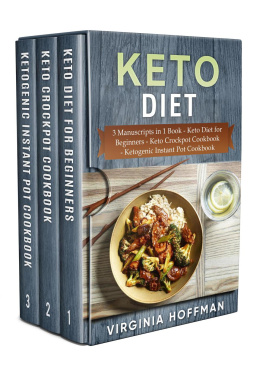
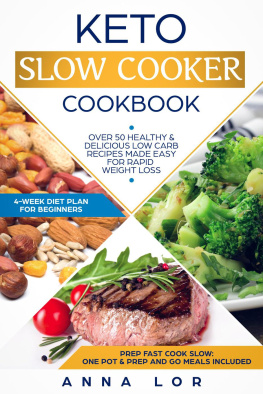
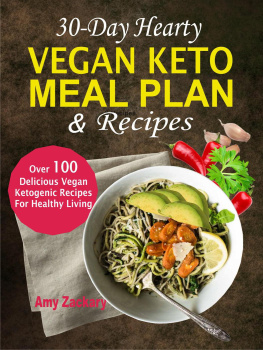
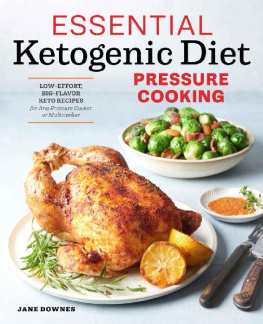
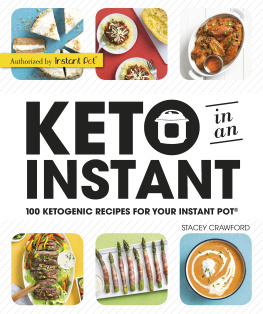


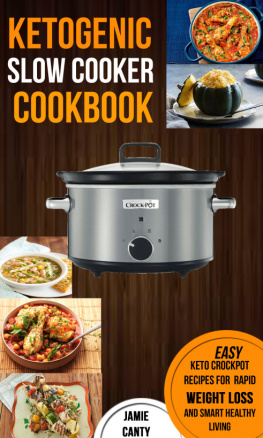
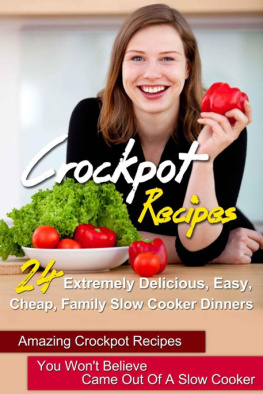
 Now that you figure out how many grams of protein, carbs and fat you are to eat per day, the next question is how do you know how much of what you eat has how many grams of fat, protein and carbs? This is done easily by using an app or an online tracking website. You need to download an app with your smartphone like the MyFitnessPal (MFP), LoseIt, and FatSecret. For those who prefer to use the computer, you can check the nutritional values online using the websites such as MyFitnessPal or LoseIt. https://www.myfitnesspal.com/ To calculate the amount of protein, carbs and fat, you will need to either estimate or weigh what you eat.
Now that you figure out how many grams of protein, carbs and fat you are to eat per day, the next question is how do you know how much of what you eat has how many grams of fat, protein and carbs? This is done easily by using an app or an online tracking website. You need to download an app with your smartphone like the MyFitnessPal (MFP), LoseIt, and FatSecret. For those who prefer to use the computer, you can check the nutritional values online using the websites such as MyFitnessPal or LoseIt. https://www.myfitnesspal.com/ To calculate the amount of protein, carbs and fat, you will need to either estimate or weigh what you eat.